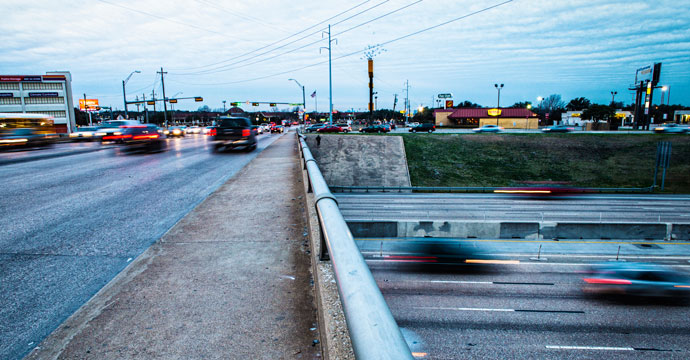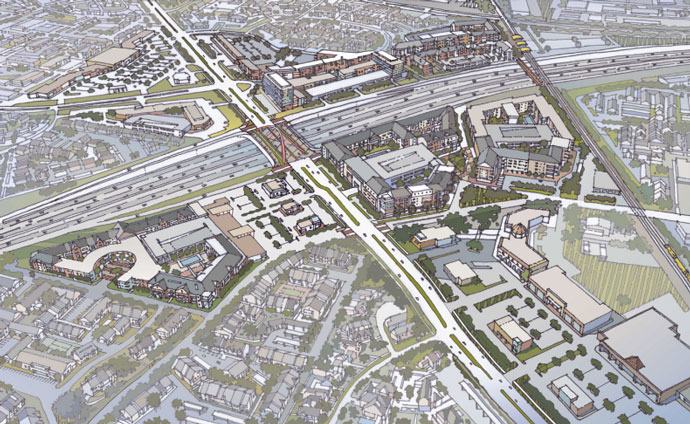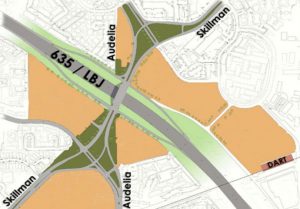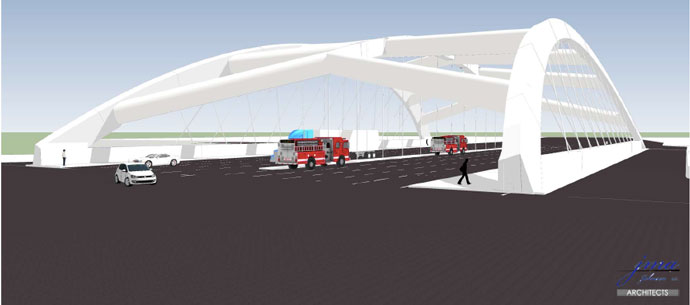
Photo by Danny Fulgencio
This is Part 1 of an ongoing series.
At 6 p.m., as darkness falls on the first Monday of the new year, the Skillman-Audelia interchange over I-635 is a nightmare.
An SUV broadsided a sedan, whose crumpled remains are at the center of this particular mess, but traffic standstills and unsettling accidents are routine for commuters who regularly traverse this thoroughfare merge.
The negative impact of this intersection goes beyond even the daily inconveniences and perils.
According to a joint study by the North Texas Central Council of Governments and the City of Dallas, it also could be severely limiting our area’s potential for economic growth.
[quote align=”right” color=”#000000″]“They designed this threaded intersection so it would cross a single bridge to get over LBJ. Then, if you fast forward to the economic boom in the late 1970s, it just mushroomed into urban density. The transportation infrastructure was never built to handle the traffic we have today.”[/quote]The thoroughfare situation, according to experts who have studied the zone for years, makes inefficient use of our land, repels quality retailers and developers, and ultimately perpetuates proliferation of undesirable businesses, problematic apartment and condominium properties, and high-crime zones.
The crossroads cause confusion and congestion, resulting in snarls, accidents and dangerous pedestrian scenarios that worsen with each passing year, and that is just the beginning, says Lake Highlands resident Susan Morgan, who has been leading the LBJ-Skillman Interchange Task Force review committee since 2006.
Authorities on city planning and design tell us that thoroughfares are barriers to future economic growth.
“So how do you get around those barriers and improve circulation so you can continue development? Those are things that you want to think about when you start talking about urban planning,” she says.
What is Lake Highlands?
When Lake Highlands residents and leaders talk about enhancing Lake Highlands, the inevitable debates over Lake Highlands’ boundaries emerge.
The Advocate in 2011 held a round-table discussion with five neighborhood pundits to address the question, “Where is Lake Highlands?” and, while we learned a great deal of Lake Highlands history, we arrived at no decisive conclusion.
Susan Morgan calls Lake Highlands a “state of mind.”
“There is no answer,” she explains, “because Lake Highlands doesn’t exactly exist.”
Yet, she concedes, “When you want to figure out the future of Lake Highlands, you have to figure out, Where is this state?”
The president of the Lake Highlands Area Improvement Association, Murray Morgan (no relation), says that what matters, when it comes to improvement and economic development, is the “greater Lake Highlands area.”
That area, he says, is the focus of the LHAIA. He loosely defines greater Lake Highlands as an area extending as far as the Richardson-Garland border, Mockingbird, Buckner, Garland, Jupiter and touching Central Expressway to the west.
The Lake Highlands Public Improvement District today encompasses 500 acres along the Skillman corridor from LBJ on the north to Abrams on the south. But if its renewal is approved this year, an extension of coverage is probable, according to director Kathy Stewart.
It is all worth consideration, but don’t spend too much time or energy worrying about the boundary-related minutiae, suggests Susan Morgan. No matter what one considers Lake Highlands, infrastructural improvement at 635 (also known as LBJ), Skillman and Audelia is vital — to the economic development of the areas surrounding it, of course. But it also has the potential to drive traffic, visibility and desirability to the entire greater Lake Highlands area.
Let us get this straight
In the late 1960s, Skillman and Audelia passed through farmland. The trajectory of 635 shot awkwardly through the intersection of the two roads.
“They designed this threaded intersection so it would cross a single bridge to get over LBJ,” Susan Morgan explained in a past Advocate interview. “Then, if you fast forward to the economic boom in the late 1970s, it just mushroomed into urban density. The transportation infrastructure was never built to handle the traffic we have today.”
Some Lake Highlands residents, professionals in their respective fields, so believe in the magnitude of the 635-Skillman realignment project that they have dedicated untold hours to it over the past several years, Susan Morgan says.
She got involved 15 years ago, at a town hall meeting where people were complaining about losing retail in Lake Highlands. When City Councilman Alan Walne asked for civilian help attracting retail, Morgan volunteered.
She also was a member of the LHAIA board. These roles, in 2006, led to her working on the District 10 Strategic Plan in conjunction with the City of Dallas’ ForwardDallas! Comprehensive Plan. That was when she set her sights on the neglected 635-Skillman area.
“I noticed that the 635 intersection was highlighted in the plan as a strategic opportunity,” Morgan says, “But at the time, all attention was focused on the Lake Highlands Town Center.”
She told Walne’s successor, Bill Blaydes, she wanted to lead the 635-Skillman improvement effort.
“He looked at me over his glasses and said, ‘You know you’ll be doing this for 10 years?’ And he was right,” she says. “I’ve been at it for eight now.”
[quote align=”right” color=”#000000″]See the entire plan for the 635-Skillman area improvement.[/quote]At that point, she recruited a team of specialists in various fields to assist.
“That is one of the many wonderful things about Lake Highlands. You ask for help, and people raise their hands. I found 10 people who came out of the woodwork with relevant areas of expertise in civil engineering, commercial architecture, real estate and transportation.”
It was immediately evident that every attempt to improve safety, economic development and aesthetics in the area would be thwarted until the transportation infrastructure was addressed, she says. “The realignment is the linchpin” of the overall 635-Skillman urban plan.
Building a bridge
Susan Morgan’s team met with the Texas Department of Transportation (TxDOT), which already had a long-term plan in place that included the realignment of Skillman.
But TxDOT’s plan was not attractive, she says.
TxDOT’s original realignment plan hinged on a flyover, an elevated street that would connect Skillman north of 635 to Skillman south of 635, bypassing the perplexing road alignment where Audelia intersects Skillman.
“It would expedite vehicles through the intersection, but it would have had no positive impact on the development potential of the surrounding properties,” Morgan explains.
Longtime Lake Highlands resident and committee member Tip Housewright volunteered his architectural firm, Omniplan, to modify the design scheme.
Omniplan designed an at-grade bridge that straightens Skillman and modifies the Audelia intersection.
The revised plans not only showcase a more aesthetic bridge — Susan Morgan calls it “iconic” looking — but also, according to the 635-Skillman study, it frees up some nine acres of “existing right-of-way land which will become an opportunity for new development.” (Part 2 of this series explores possibilities for said property.)
Making it happen

Preliminary sketch of the plan to realign Skillman: Provided by TxDOT and the City of Dallas.
The City of Dallas, Federal Highway Administration and TxDOT all have approved the design, and it has progressed to TxDOT’s detail design phase.
The project at this point is close to what the industry calls “shovel-ready,” Susan Morgan says. The term is used to describe projects whose planning, engineering and funding have advanced to a stage where laborers may immediately begin construction.
The project is imminent, but we aren’t there yet, Morgan says. The realignment project totals $50 million and about $38 million more is needed to fund it.
The $3.8 million spent to date, mostly on feasibility studies and engineering design, was cobbled together through the City of Dallas bond program and TxDOT funding, Morgan explains, adding that Omniplan donated its services.
There are several options for accruing the remaining necessary dollars.
For example, shovel-ready projects are more likely to receive government stimulus grants. There are also new Department of Transportation funds available in 2015. Both are potential sources for financing the realignment project.
TxDOT’s I-635 LBJ East project — the long-term plan that originally included the rejected 635-Skillman flyover — also includes funding for the realignment.
If we have to wait on those funds, it could take longer. Morgan says she hopes to break ground on the bridge before her 10 years are up.
What could this new bridge mean for Lake Highlands? We explore that in next month’s installment of “A vision for Lake Highlands.” Subsequent segments will include a closer look at the I-635 LBJ East project, the upcoming District 10 City Council election and more.







